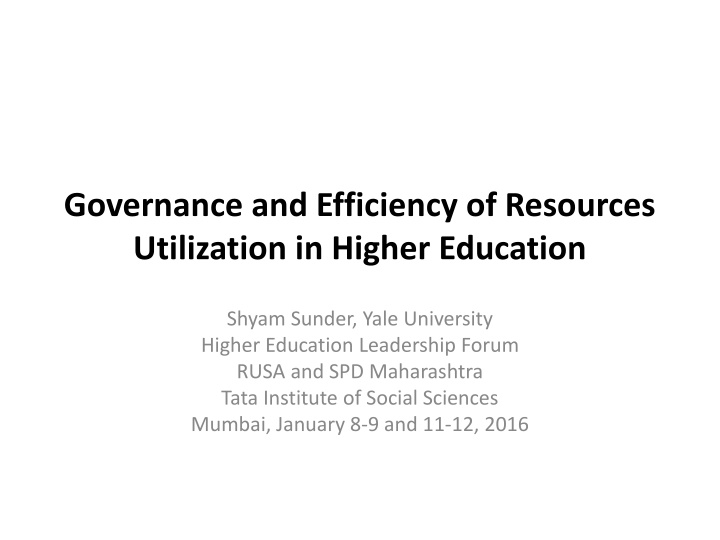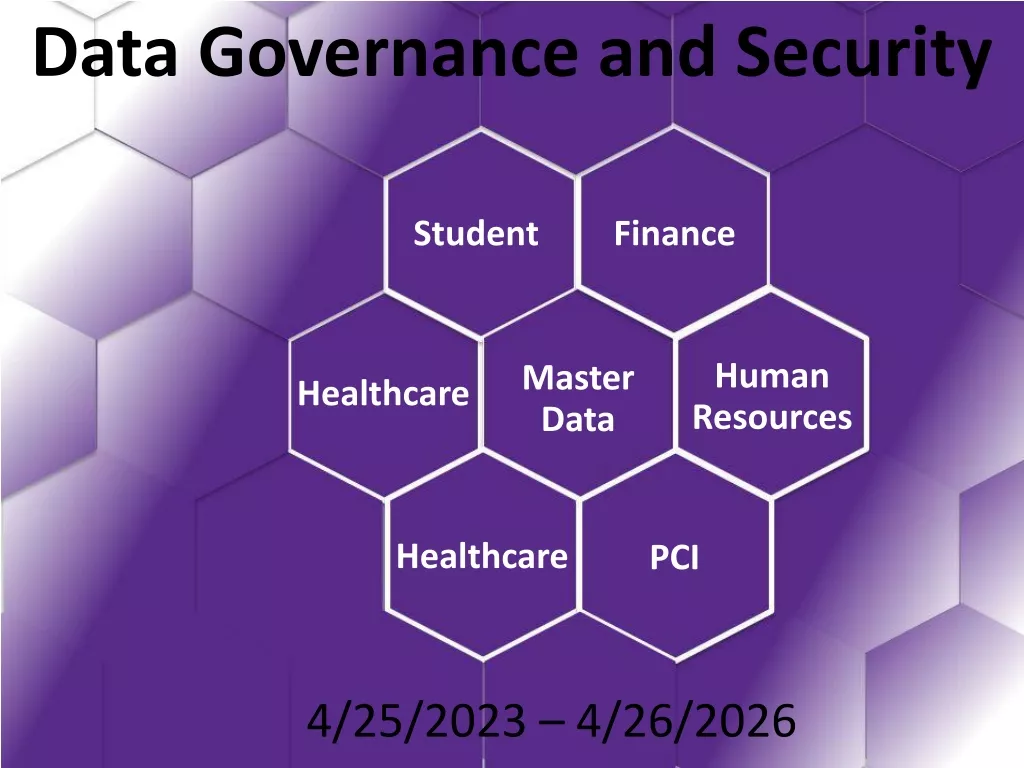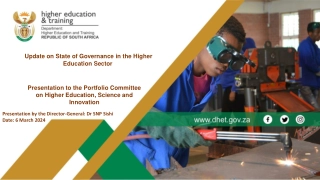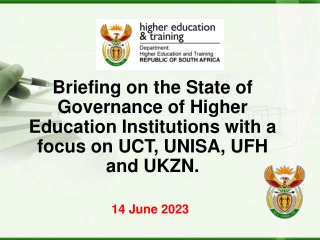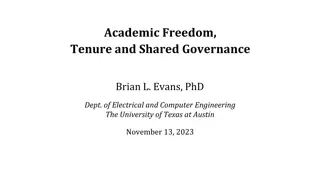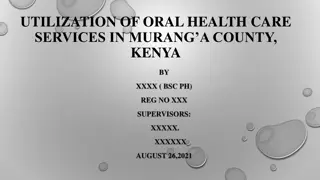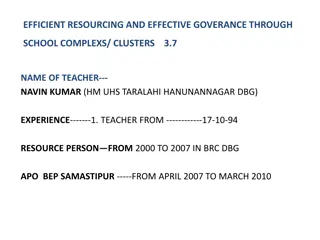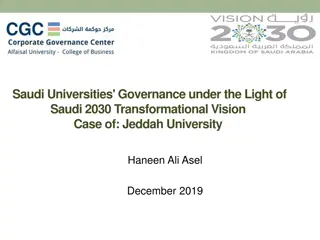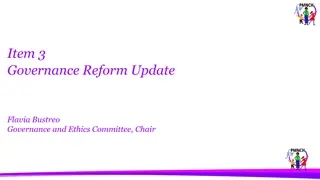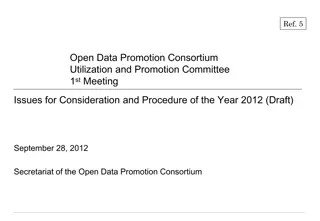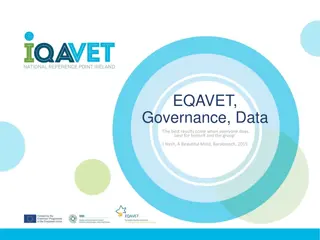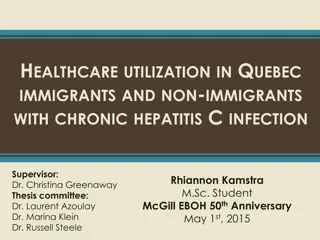Governance and Efficiency of Resources Utilization in Higher Education
Demand for higher education in India exceeds supply, necessitating efficient resource usage. This presentation discusses obstacles, governance models (bureaucracy vs. business), and when to apply each model based on goods classification. It offers insights for higher education reforms in India.
Download Presentation

Please find below an Image/Link to download the presentation.
The content on the website is provided AS IS for your information and personal use only. It may not be sold, licensed, or shared on other websites without obtaining consent from the author.If you encounter any issues during the download, it is possible that the publisher has removed the file from their server.
You are allowed to download the files provided on this website for personal or commercial use, subject to the condition that they are used lawfully. All files are the property of their respective owners.
The content on the website is provided AS IS for your information and personal use only. It may not be sold, licensed, or shared on other websites without obtaining consent from the author.
E N D
Presentation Transcript
Governance and Efficiency of Resources Utilization in Higher Education Shyam Sunder, Yale University Higher Education Leadership Forum RUSA and SPD Maharashtra Tata Institute of Social Sciences Mumbai, January 8-9 and 11-12, 2016
An Overview Demand for higher education far exceeds the supply (in quantity and quality) India s resource constrained environment Efficient utilization of resources is critical in India Many obstacles to increasing efficiency Conflicting pulls (e.g., university as employment agency, labor laws, business lobby, faculty, administrative set up, and corruption) I shall talk about a framework for thinking about solutions and alternative approaches We could discuss and each of you will have to think about how they might be adapted to work in your individual institutions Higher Education Reforms in India (c) Shyam Sunder 3/2/2025 2
Two Basic Models of Governance Bureaucracy Business Higher Education Reforms in India (c) Shyam Sunder 3/2/2025 3
Bureaucracy Model of Governance Kautilya and Weber Characteristics Hierarchical structure Functional specialization Operating rules, procedures, and precedent Promotion from within Fixed compensation (no bonus, incentives) Impersonal (little discretion) Budgets, not profits Higher Education Reforms in India (c) Shyam Sunder 3/2/2025 4
Business Model of Governance Matrix structure (product managers) Markets (labor, products, capital), not rank Incentives Profit orientation Innovation Open to talent from all sources Higher Education Reforms in India (c) Shyam Sunder 3/2/2025 5
When Do We Use Bureaucracy and Business Form of Governance? Goods and services can be classified into two broad categories Private goods examples Public goods: two properties Non-rivalrous consumption Non-excludable consumption Many goods and services lie somewhere in between Organization and governance depends on the nature of the output of the organization Macro organization and micro-level analyses Higher Education Reforms in India (c) Shyam Sunder 3/2/2025 6
Education a Public or Private Good? Elementary education Secondary education College (bachelor s) education Graduate education (MS, PhD) Professional education (MBA, medicine, law, dentistry, etc.) Implication of financing of each level of education Higher Education Reforms in India (c) Shyam Sunder 3/2/2025 7
Look inside: Governance of Functions (Bureaucratic or Business Model) Strategic planning Organizing Hiring faculty Funding Curriculum Admissions Examinations/student evaluation Communications/communit y relations Purchasing Faculty evaluation and promotion Compensation Non-teaching personnel Buildings and facilities management Food services Libraries Research Board of Trustees/Directors More Higher Education Reforms in India (c) Shyam Sunder 3/2/2025 8
Think about Governance of Each Function Take each function and decide on whether you would use bureaucratic or business model for managing each of these functions in your university What are the problems and why? Higher Education Reforms in India (c) Shyam Sunder 3/2/2025 9
Higher Education Reforms in India (c) Shyam Sunder 3/2/2025 10
Financing India s expenditures (12.73% of government spending, 3.46% of GDP in 2005-6) comparable to developed countries But large chunks already assigned to low productivity research labs run by civil service rules, not innovation With competing developmental demands, substantial increase in government funding is not likely Only other sources: students (either cutting back on massive subsidies at older government schools or commercialization of higher education), or Philanthropy (long tradition in India); money and management See financing of U.S. universities In India, even genuinely NFP universities derive close to 100% revenue from students; others make profits Only Microsoft supports advanced theoretical research in India Higher Education Reforms in India (c) Shyam Sunder 3/2/2025 11
Revenue from Students at 39 US Universities Higher Education Reforms in India (c) Shyam Sunder 3/2/2025 12
Financing of Universities in China (Ministry of Education) Revenue Composition of Regular Institutions of Higher Education in PRC (in percent) 100 90 80 70 60 State funding 50 Tuition & fees Other income 40 30 20 10 0 1993 1994 1995 1996 1997 1998 1999 2000 2001 2002 2003 2004 2005 Higher Education Reforms in India (c) Shyam Sunder 3/2/2025 13
Some Tentative Suggestions Structural change: integrating education and research Closing super-specialized single-topic institutes No profit-making institutions except in vocational training Higher Education Reforms in India (c) Shyam Sunder 3/2/2025 14
Structure of Innovation/Research in India Structural obstacles to promote research and innovation After independence, set up specialized research organizations initially attracted talented scientists and engineers to research Were well financed by government, had little contact with education, industry or the market (business was a dirty word) With a few exceptions, isolated from the fresh air and inconvenient discipline of the market and contact with the young minds, most laboratories gradually fell into bureaucratic routine, promoting largely by seniority, spending the budget, producing little research or innovation (India hardly appears in the world research map) The civil services that run these organizations, e.g., Council for Scientific and Industrial Research, control much of government budget for promoting innovation Higher Education Reforms in India (c) Shyam Sunder 3/2/2025 15
Policy of Separating Research from Education Second, most of the government budget for innovation captured by these organizations, leaving little for universities Third, isolation of research from the education of the young Universities reduced to classrooms printing diplomas Starved of talent in faculty, funding for innovation, and research culture. In such environment, even talented students had no exposure to research, no opportunities for even accidental discovery of their affinity for innovation. The few PhD programs that existed could not attract young talent Most members of faculty could not do or supervise research The quality of people entering the PhD program lowered the social regard for academia; this vicious cycle of mutual reinforcement continues Higher Education Reforms in India (c) Shyam Sunder 3/2/2025 16
Separation of Research from Teaching System of independent bunkers for research and teaching, had devastating consequences Neither research (no youth) nor education (no money and talent) Functioning by civil service rules, little mobility, competition, or industry contact Low quality of students in PhD programs Narrowly defined disciplinary charters of research labs as well as educational institutions Signboards of National/Indian Institute of XYZ in and around Delhi (e.g., National Defence University at 3B rupees, 200 acres, why not on a university campus?) Consequences of free-standing special purpose universities Legislative and financial controls: 15 councils each with its own act of Parliament; every ministry is an education ministry Higher Education Reforms in India (c) Shyam Sunder 3/2/2025 17
Super-Specialization A fourth consequence: narrow charters of research institutes did not allow focus on the exciting interfaces of disciplines where innovation occurs as Each institute, defined by its own agenda or discipline, bound by its own charter, did not facilitate or encourage casual interaction with ideas from outside that may occur in broader university settings Will an institute to conduct research on candles discover electricity Will an institute to conduct research on horse carts invent a car Imposition of narrow super-specialization has damaged India s education system Importance to diploma, not to the creativity of a young mind Importance to administrative authority, not to originality of thinking and power of ideas Human Indian scientists known for their science, not authority Higher Education Reforms in India (c) Shyam Sunder 3/2/2025 18
Administrative Issues Physical vs. human resources Every ministry is in education Regulatory waste Political, civil service and commercial control Indian constitution and the political power of teachers Enforcement of societies act Resource use and productivity Public good aspects of higher education Internal governance and evaluation of faculty Personnel policies Higher Education Reforms in India (c) Shyam Sunder 3/2/2025 19
Physical vs. Human Resources Planning and governance dominated by physical resources property and goods as wealth of society Creative ability of people to think and do receives less attention Higher education plans consist of: acres, square meters of building space, employment, budgets, degree programs and diplomas granted The critical feature of education the talent necessary to think, innovate, inspire, and teach is more difficult to judge, is not emphasized, and remains in short supply Prescription of the Pharmacy Council of India: The nature and period of study of practical training to be undertaken before admission to an examination; the equipment and facilities to be provided for students undergoing approved courses of study; the subject of examination and the standards therein to be attained; and any other conditions of admission to examinations. What is missing here? Higher Education Reforms in India (c) Shyam Sunder 3/2/2025 20
Every Ministry is Education Ministry Fifteen councils, controlled by various ministries under various acts of Parliament Ministry of Health and Family Welfare controls Pharmacy Council of India Everybody protects their turf Collective opposition of all ministries and councils to Yash Pal Committee recommendation for integration of education Need strong political leadership to change Higher Education Reforms in India (c) Shyam Sunder 3/2/2025 21
Regulatory Waste Mind-numbing detail in regulations to avoid discretion E.g., Dental Council of India: 5 acres, 30-year lease, 600-1,000 sq. ft./student, 50% living space, Rs.200,000 per student plus bank guarantee but no mention of faculty Avoiding fly-by-night operators, but permitting veritable Taj Mahals ignoring their opportunity cost and limits on enrollments Higher Education Reforms in India (c) Shyam Sunder 3/2/2025 22
Political, Civil Service and Commercial Control We do not need to go into them here. Outsized control of ex officio presence of civil servants on policies Higher Education Reforms in India (c) Shyam Sunder 3/2/2025 23
Constitutional Power of Teachers Low level of expectations (and performance) from teachers Between civil service rules and intensive unionism of teachers, how do you specify obligations for inspired teaching and brilliant scholarship? Execessive democracy on campus Article 171(3c) of Indian Constitution Higher Education Reforms in India (c) Shyam Sunder 3/2/2025 24
Enforcement of Societies Act Traditional charitable and managerial participation of civil society in higher education being overtaken by commercial interests Focus: Return on invested capital Failure of the government to enforce the Societies Act Well-intentioned land grants for education become private source of wealth Financial transparency and accountability through prompt publishing on audited financial reports Higher Education Reforms in India (c) Shyam Sunder 3/2/2025 25
Resource Use and Productivity High unfulfilled demand for higher education, low enrollment ratio, and scarcity of resources for higher education coexist with anomalous pattern of resource allocation by government Sprawling academic campuses in middle of cities with well-separated low-rise buildings on high value land on which 10 or 20 times as many students could be given quality education if faculty were available Provision of campus housing makes VCs and Directors mayors as well as land lords, high capital cost, lowers capacity Higher Education Reforms in India (c) Shyam Sunder 3/2/2025 26
Some Consequences of Building Staff Housing on Campus Significantly higher (50%?) capital costs; less educational capacity can be financed Directors/Vice Chancellors as mayors managing a colony and its problems (e.g., maintenance), distracting attention from urgent academic tasks Makes the real cost of staffing hidden in historical costs Misallocation of housing (rank, substitution) Lowered mobility of faculty and staff Intensified politics w/o separation of work and home Higher Education Reforms in India (c) Shyam Sunder 3/2/2025 27
An Alternative Proposal Reserve a piece of campus land for long term lease to multiple competing private builders Private companies build-operate rental housing on leased land for exclusive use of current employees at market prices Staff get cash salaries and decide on housing Builder/investors choose rental rates Advantages of campus w/o high capital costs, managerial distractions, hidden costs, or mobility problems Build educational capacity for three with the cost of two Generate even better alternatives through discussion Higher Education Reforms in India (c) Shyam Sunder 3/2/2025 28
Internal Governance and Evaluation of Faculty Difficulty of objectively measuring accomplishment Universities depend on shared values among students, faculty, staff, administration, parents, government, donors, and the society Values too delicate to stand up to hard-ball confrontation and tactics by which various constituencies may seek their own rights with little shared understanding and obligation for their responsibilities Absent shared expectations and values, no university can deliver quality education, no matter how talented the administration is Degradation of education is the first victim of conflict. Almost immediate tenure to faculty Since subjective judgment may be abused, bright line rules made in Asia, damaging research cultures and intellectual discourse Higher Education Reforms in India (c) Shyam Sunder 3/2/2025 29
Personnel Policies Importance to degrees and administrative authority, and seniority Creativity, originality of young minds ignored Scholars without administrative authority rarely in public domain P. Anandan : India doesn't make heroes of its researchers. Catch 22 of Indian scholarship: scholars become civil servants to have control over their work, which leaves them little time for scholarly work. Civil servants can rarely independently to judge scholarship and art, it is reasonable for them to rely on the judgment of eminent people in the field This involvement in administrative matters also consumes time that would otherwise be spent on creative or scientific work India, like China, uses age and seniority as qualifications for decision-making, putting meritorious young scholars and their heterodox ideas at a disadvantage. Higher Education Reforms in India (c) Shyam Sunder 3/2/2025 30
Thank You! Shyam Sunder, Higher Education Reforms in India in Chetan Ghate, ed. Oxford Handbook of the Indian Economy (2012) Shyam.Sunder@yale.edu www.som.yale.edu/faculty/sunder
